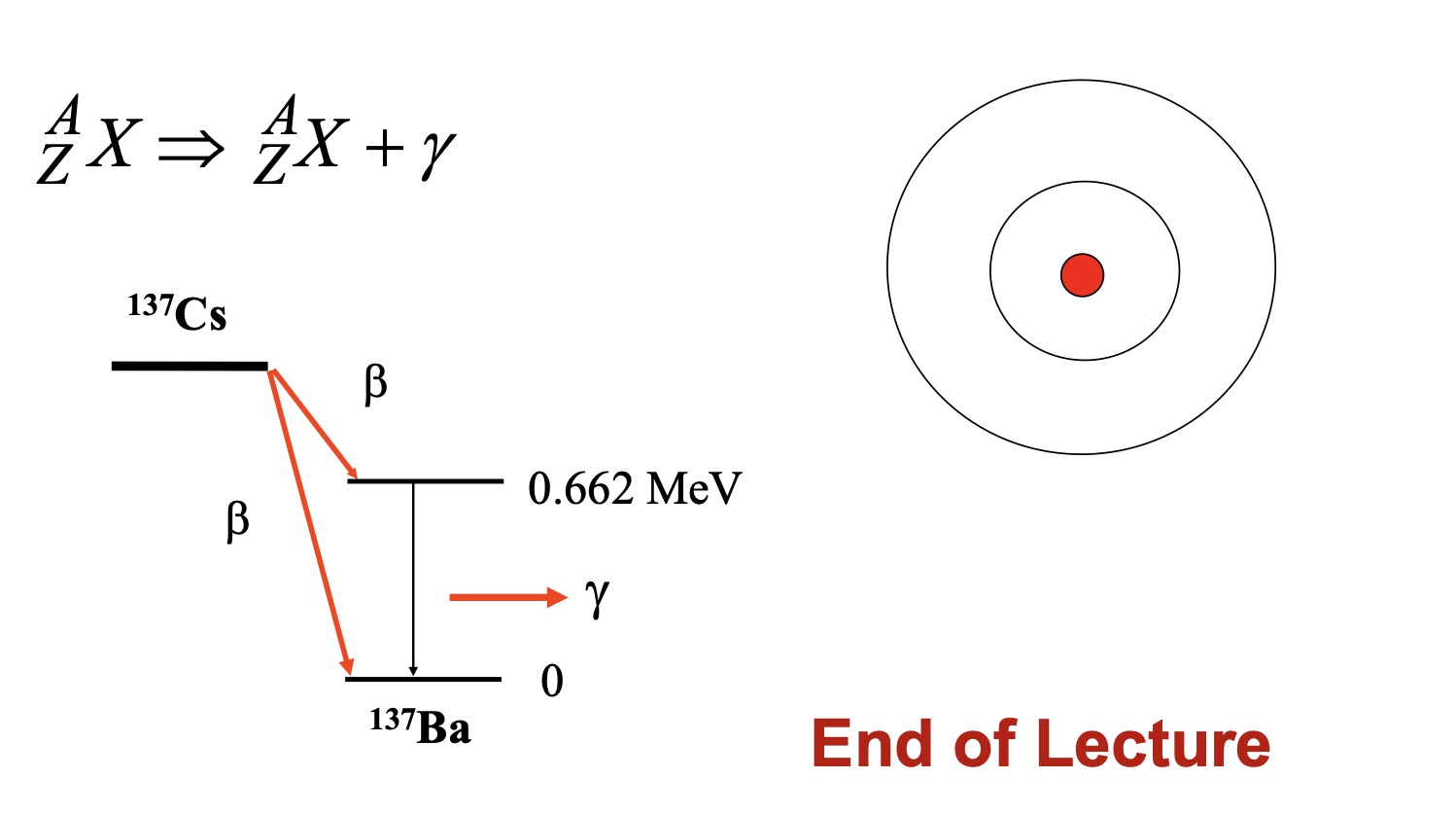Lecture 19: Atomic and Nuclear Radiation
1/29
There's no tags or description
Looks like no tags are added yet.
Name | Mastery | Learn | Test | Matching | Spaced |
|---|
No study sessions yet.
30 Terms
applications of atomic and nuclear radiation
nuclear medicine
MRI
smoke detector
radioactive dating
agriculture and engineering
what is the nucleus
densely packed centre of an atom composed of protons and neutrons
protons are + and their mass is
1.67262 × 10^-27 kg
neutrons and neutral and their mass is
1.67493 × 10^-27 kg
neutrons and protons are collectively called
nucleons
number of protons is recognised as the
atomic number of an atom
total number of nucleons is the
atomic mass number (protons + neutrons)
where to find atomic number and atomic mass number on periodic table

Radius of a nucleus
R = (1.2 × 10^-15)A^(1/3)
where A is the number of nucleons
what is nuclear mass
measured using mass spectrometer and expressed with reference to the mass of a carbon12 atom which is assigned the mass of 12u, where u is unified atomic mass unit defined as:
1 uamu = 1/12(mass of 1 carbon 12 atom)
1 u = 1/12(12g/6.02×10^(23))=1.661×10²² g 1.66 × 10^(27) kg
masses can also be expressed in terms of their energy equivalent. What is the energy equivalent of 1 amu
E = mc²
E = energy
m = mass
c = speed of light
NOTE: Joules to Ev
1 eV = 1.6 × 10^-19 J
What is binding energy
The total mass of a nucleus is always less than the mass of protons and neutrons in it.
This mass difference is a measure of the BINDING ENERGY that holds the nucleus together.
BE = ∆m x 931.5 MeV/u
calculate the binding energy of helium
helium has 2 protons and 2 neutrons, find the mass of protons and neutrons in u
2(mass of proton) + 2(mass of neutron) - atomic mass number of helium = delta m = mass defect
then use BE = delta m x 931.5 MeV/u.
what holds nucleons together
nuclear force (binds nucleons together)
attractive between protons, protons and neutrons, and neutrons
short range (attracts only nearest neighbours 10^-15m)
column force (break protons apart)
repulsive for protons
long range - acts across the nucleus
for a nucleus to be stable
attractive force between nucleons must overcome the repulsive force between protons
Towards the end of the 19th century, minerals were found that would darken a photographic plate even in the absence of light. Why?
they emit radiation!
this phenomenon is now called radioactivity
marie and pierre curie isolated two very radioactive elements = radium and polonium
what is radioactivity the result of
integration or decay of an unstable nucleus
certain isotopes are unstable, they decay with…
emission of some types of radiation or rays
Rutherford found that
the rays could be classified into three distinct types according to their penetrating power.
3 types of radiowaves
alpha, beta, and gamma rays.
alpha rays
barely penetrates a piece of paper
beta rays
could pass through as much as 3 mm of aluminium
gamma rays
It could pass through several centimetres of lead and still be detected on the other side
charges of radiation
alpha - positive
beta - negative
gamma - neutral
what is radioactivity
Spontaneous emission of radiation from unstable nuclei.
α, β and γ emission.
types of particles for alpha, beta and gamma rays
All three consisted of familiar kind of particles.
Gamma rays are very high energy photons.
Beta rays are electrons, identical to those that orbits the nucleus, but they are created within the nucleus itself.
Alpha rays are simply the nuclei of helium atoms. That alpha ray consists of two protons and two neutrons bound together.
energy released in nuclear decay
Q = [Mp - (MD + Malpha)] x c²
Q = disintegration energy
Mp = mass of parent
MD = mass of daughter
Malpha = mass of particle
c = speed of light
![<p><em>Q </em><span>= [Mp - (MD + Malpha)] x c² </span></p><ul><li><p>Q = disintegration energy </p></li><li><p>Mp = mass of parent </p></li><li><p>MD = mass of daughter </p></li><li><p>Malpha = mass of particle </p></li><li><p>c = speed of light </p></li></ul><p></p>](https://knowt-user-attachments.s3.amazonaws.com/e2b17b4a-908c-4d1d-a482-c79ab20a341d.png)
how does a smoke detector work
contains 0.2 mg of the radioactive americium isotope Am-241 in the form of AmO2. (1.0 µCi)
α particles from Am-241 continually ionizes the air molecules in the air space between the two oppositely
charged plates.
The positive and negative ions are attracted by the charged plates which results in a current flow through the circuit.
When smoke enters between the plates, the ions becomes attached to the smoke particles, thus resulting in a drop of current.
The current drop is detected by the electronic circuitry and sets off the
alarm.
summary of alpha decay and beta decay

gamma decay
photon is emitted from an excited nucleus
it is like the emission of photons from an excited atom
